Do you have a question about the Samsung RS265BBWP and is the answer not in the manual?
Details general precautions and safety warnings for handling and repairing the refrigerator.
Explains the meaning of various caution and warning symbols used in the manual.
Provides specific prohibitions and cautions for users to prevent hazards and damage.
Highlights key characteristics and functions of the refrigerator, such as Twin Cooling and Multi-Flow.
Lists electrical, performance, and refrigeration system specifications for the models.
Illustrates the interior layout and components of the freezer and refrigerator compartments.
Compares specifications of Samsung models with Whirlpool and GE models.
Presents a specification chart detailing net capacity, dimensions, power, and refrigerant.
Provides detailed dimensional drawings of the refrigerator in inches.
Lists optional materials including water filter and lamp with their respective part codes.
Illustrates the flow path of the refrigerant through the refrigeration system.
Diagrams showing how cold air circulates within the freezer and refrigerator compartments.
Explains the functions and display of the digital control panel for temperature settings.
Details how to set and adjust temperatures for the freezer and refrigerator compartments.
Describes how to activate and use Power Freeze and Power Cool functions for rapid cooling.
Explains how to enable and disable the child lock feature to prevent accidental operation.
Details the operation of the ice and water dispenser, including ice type selection and water dispensing.
Explains the operation of the condenser fan motor based on ambient temperature.
Describes the CoolSelect Zone drawer's functions like Quick Cool, Thaw, and Select modes.
Explains the function and reset procedure for the water filter indicator light.
Details the operation of the ice maker, including ice production and storage.
Explains the automatic defrost cycle determination and heater operation.
Provides instructions for safely installing the refrigerator, including door removal and reattachment.
Details how to perform pull-down, defrost, and cancellation modes for forced operation.
Explains the sounds produced by button inputs and the door open alarm.
Describes the cooling off mode, used for display purposes, and how to activate/deactivate it.
Explains how the refrigerator performs self-diagnostics upon power-on and during normal operation.
Details how to check the operation status of various components via the display panel.
Explains how functions are restored or initialized after a power interruption.
Describes how to adjust temperature set points for freezer, refrigerator, and other zones.
Provides tables for shifting temperature sensor set points for various components.
Step-by-step guide to removing the freezer door, including hinge and water line disconnection.
Instructions for removing the refrigerator door, covering hinges and covers.
Procedure for removing the refrigerator's control panel using a screwdriver.
How to remove the door gasket by grasping and pulling it from the liner.
Instructions for removing the refrigerator and freezer door handles.
Guide to removing the refrigerator's door light switch.
How to remove tempered glass shelves for cleaning or replacement.
Procedure for removing plastic drawers from the refrigerator compartment.
Instructions on how to remove gallon door bins from the refrigerator door.
Guide to removing and installing the water filter by turning it counterclockwise.
Steps to remove the evaporator cover in the refrigerator, including screws and tabs.
Procedure for removing the upper duckwork and associated covers and connectors.
Guide to removing the evaporator fan motor assembly from the freezer.
Instructions for removing the evaporator from the refrigerator compartment.
How to remove door bins from the freezer compartment.
Procedure for removing the freezer door light switch.
How to remove plastic drawers located in the lower portion of the freezer.
Instructions for sliding out and removing freezer shelves for access.
Guide to removing the ice dispenser and ice maker assembly.
Steps to unlock tabs and separate the ice maker kit.
Procedure for removing the auger motor case supporting the ice maker.
How to remove the freezer light cover and bulb.
Steps to remove the evaporator cover in the freezer compartment.
Procedure for removing the upper ductwork and associated connectors.
Guide to removing the evaporator fan motor assembly from the refrigerator.
Instructions for removing the evaporator from the freezer compartment.
How to locate and remove the freezer thermistor.
Procedure for locating and removing the ice-maker thermistor.
Guide to locating and removing the ambient thermistor inside the upper hinge cover.
Steps to disassemble the fan motor located in the machine compartment.
Flowchart to diagnose and resolve issues when the refrigerator does not power on.
Troubleshooting steps for when the compressor and cooling fan motors do not operate correctly.
Diagnostic steps for problems related to the refrigerator's defrost function.
Guides for troubleshooting issues identified through the refrigerator's self-diagnosis system.
Diagnosing and resolving issues related to continuous or intermittent alarm sounds.
Troubleshooting steps for when the panel PCB is not working normally, including lighting issues.
Diagnostic procedures for issues where the refrigerator or freezer fans are not working.
Troubleshooting steps for when the CoolSelect Zone is not operating as expected.
Diagnosing and resolving issues where freezer or refrigerator lamps fail to light.
Troubleshooting steps for issues with crushed or cubed ice dispensing.
Exploded view and parts list for the freezer section of the refrigerator.
Exploded view and parts list for the refrigerator section of the unit.
Exploded view and parts list for the cabinet and its related components.
Exploded view and parts list specifically for the freezer door disassembly.
Exploded view and parts list related to the disassembly of the refrigerator door.
List of miscellaneous parts not categorized elsewhere, such as ties and screws.
Overview of the refrigerator's system architecture and component connections.
Detailed wiring diagram for specific refrigerator models.
Detailed wiring diagram for specific refrigerator models.
Diagram showing the physical layout of components on the main PCB.
Illustrates the arrangement and pinouts of connectors on the main PCB.
Description of the power supply circuit that converts AC input to DC voltages.
Explanation of the oscillator circuit used for generating synchronous clocks.
Details the reset circuit's function in initializing microprocessor values.
Describes how the door switches are sensed by the microprocessor.
Explains the operation of thermistors used for temperature sensing.
Details the circuit responsible for scanning keys and displaying information.
Description of the CoolSelect Zone display panel and its temperature sensor circuit.
Explanation of the drive circuit for BLDC fan motors, including voltage specifications.
Description of the EEPROM circuit for semiconductor memory.
Details the option circuit used for setting different model functions.
Explanation of how loads like compressors and heaters are controlled via the main PCB.
Outlines essential safety steps before and during refrigerator repair and replacement.
Instructions for checking wire connectors on the cabinet door and main PCB.
Procedure for checking relay failure by measuring voltages and resistances.
Method for checking loads like heaters and solenoid valves for resistance and continuity.
Instructions for measuring sensor resistances and checking connections.
Procedure for checking the door switch operation and its effect on lamps and sensors.
Lists service materials and circuit boards used in the refrigerator.
Explains the naming convention and components of the refrigerator model name.
Provides answers to frequently asked questions about refrigerator performance and issues.
| Brand | Samsung |
|---|---|
| Model | RS265BBWP |
| Category | Refrigerator |
| Language | English |


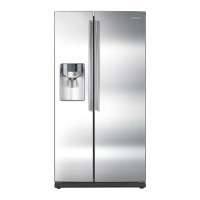

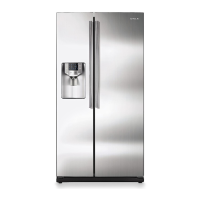

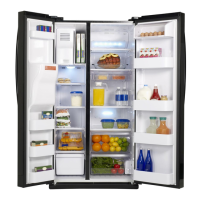

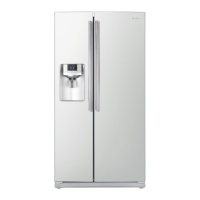

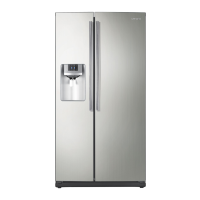

